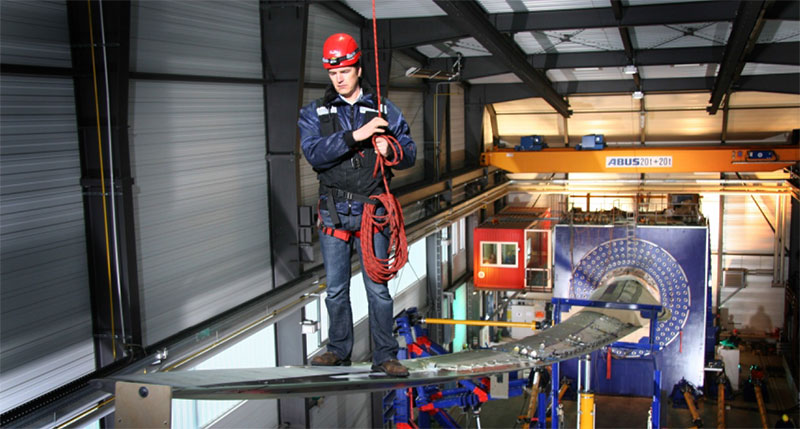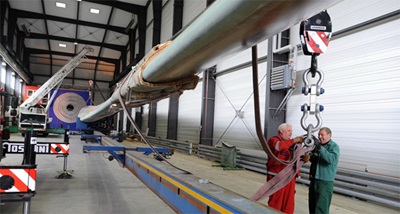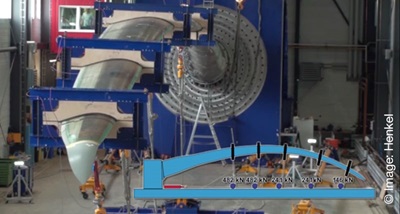Rotor blade testing at the IWES
Innovative life-cycle monitoring with AICON’s measuring technology
Contact us

“Better Blade” – Project for an innovative testing method
Particularly for rotor blades in wind power stations, reliable predictions concerning the durability are indispensable. When do rotor blades fatigue, when get material defects visible? The behavior of the blades with respect to fatigue, i.e. the initiation and growth of structural defects, must be assessed before the system is put into operation. In order to improve the testing procedure for the certification of the rotor blades, the Rotor Blade Centre at the IWES under the responsibility of Dr. Arno van Wingerde has established the “Better Blade” project.
 Falko Bürkner, project manager for rotor blade testing, summarizes the targets of the “Better Blade” project as follows: “The measuring method used until now, is no more sufficient for the latest generation of wind power stations. To optimize the required accuracy, we have analyzed the entire process, identifying the cable pull potentiometers as the essential weak point. Above a certain cable length, the response time of the arrangement increases, so that it becomes impossible to monitor highly dynamic load changes at the required precision. It will be unavoidable to replace this configuration by an optical 3D measurement system, which does not comprise any coupling between the device itself and the sample.”
Falko Bürkner, project manager for rotor blade testing, summarizes the targets of the “Better Blade” project as follows: “The measuring method used until now, is no more sufficient for the latest generation of wind power stations. To optimize the required accuracy, we have analyzed the entire process, identifying the cable pull potentiometers as the essential weak point. Above a certain cable length, the response time of the arrangement increases, so that it becomes impossible to monitor highly dynamic load changes at the required precision. It will be unavoidable to replace this configuration by an optical 3D measurement system, which does not comprise any coupling between the device itself and the sample.”
The optical system MoveInspect HF has been examined carefully for this application and proved, that it is able to deliver highly precise results in real-time, not depending on the current displacement of the blade.
Requirements for the 3D measurement system
But MoveInspect HF has to meet further requirements. The team of Dr. Arno van Wingerde collected a requirements catalog not only regarding accuracy but also with regard to test related situations:
1. Static load tests
 The specification in principle describes not one single, but a sequence of individual static tests. Before the blade will undergo the procedure, it will be bolted to a reinforced concrete block. The load is induced in the form of a vertical downward movement, by means of hydraulic cylinders, ropes and deflection rollers. The deformation takes place in a range between 1 and 20 m, with a short stop at several distinct positions. The task of the measuring system is to track the current position in space, and to transmit the 3D coordinates to the central data processing unit per CAN bus. Crucial point is, besides the required accuracy, the large number of points to be supervised simultaneously over a long period of time.
The specification in principle describes not one single, but a sequence of individual static tests. Before the blade will undergo the procedure, it will be bolted to a reinforced concrete block. The load is induced in the form of a vertical downward movement, by means of hydraulic cylinders, ropes and deflection rollers. The deformation takes place in a range between 1 and 20 m, with a short stop at several distinct positions. The task of the measuring system is to track the current position in space, and to transmit the 3D coordinates to the central data processing unit per CAN bus. Crucial point is, besides the required accuracy, the large number of points to be supervised simultaneously over a long period of time.
2. Cyclic load tests
In the course of their lifetime, rotor blades will be subjected to a milionfold load changes at varying amplitudes. For purposes of test however, constant amplitude will be applied, by inciting the blade at its natural frequency in the impact or swiveling direction. A biaxial test is carried out as well, with a parallel incitation in both directions. In either case, the loads are transmitted by means of a single hydraulic cylinder located in the central range of the blade.
The values have to be detected synchronously, and to be transferred to the central data processing unit in real-time.
3. General Requirements:
Detectable deformation: up to 20 m
Data Frequency: > 100 Hertz, real-time measurements possible
Accuracy: < 2 mm, depending on object size
Record period: unlimited
Unit Configuration: mobile system

MoveInspect HF meets all requirements!
The examination of the MoveInspect HF was an overwhelming success for AICON. It was not only the fitness for the particular application, which has convinced the IWES team, but also the efficiency and the recording density offered. AICON was proud to receive the corresponding order in the beginning of 2011.
Falko Bürkner illuminates the advantages of the system: “We are surprised by the cost saving offered by MoveInspect HF. Compared to our former measuring system, the cable pull potentiometers, the time required for installation for each new trial is reduced by 30 minutes. Since a large number of employees is required every time, personnel cost have been significantly lowered already for this reason. Furthermore, it is no more necessary to convert the obtained displacements. Our new MoveInspect HF presents the results directly in a rectangular system of coordinates, considerably speeding up the analysis.”
Also regarding data density MoveInspect HF exceeds all expectations. Falko Bürkner confirms: “Some of the data detected by the AICON system were unavailable until now. Classical cable pull potentiometers are not able to evaluate certain parameters, for example with respect to the lateral inclination of the blades in a test, carried out mainly under vertical load. This fact allows a more detailed analysis of the samples’ quality.”
Configuration of MoveInspect HF in the IWES application
 The MoveInspect HF system works with high resolution digital cameras, oriented to the test object. Due to the dimension of a rotor blade of up to 90 m length, four cameras are required, mounted on a tripod and positioned around the blade. By this method, any displacement of the entire specimen can be detected.
The MoveInspect HF system works with high resolution digital cameras, oriented to the test object. Due to the dimension of a rotor blade of up to 90 m length, four cameras are required, mounted on a tripod and positioned around the blade. By this method, any displacement of the entire specimen can be detected.
The test points to be surveyed are signalized with self-adhesive targets. For a rotor blade the most important point is the tip, since the largest excursion will be found here. For example: The resulting speed at the tip position will be up to 32 m/s in case of blades with an excursion at the tip of ± 10 m and a frequency of 0.5 Hz.
Since 2011 AICON’s MoveInspect HF has successfully been installed at the IWES to evaluate important information on the life cycle analysis of a large number of different rotor blades.